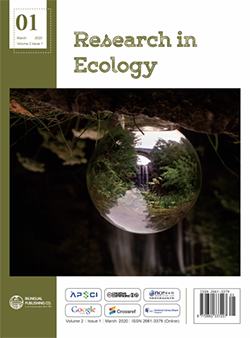
Propagation Model of Invasive Species: Road Systems as Dispersion Facilitators
DOI:
https://doi.org/10.30564/re.v2i1.1054Abstract
The globalization of the planet allowed plant species to emerge from their traditional habitats and spread to other territories. This dispersion, sometimes occasional, sometimes by the influence of man, reaches proportions today that, in some cases, affect the development of natural ecosystems and their sustainability. Thus, becomes imperative to know seeds dispersion occur, since only after can be taken measures to mitigate these processes. In the same way that natural communication paths, such as rivers, are responsible for the natural dispersal of seeds, man-made communication paths, such as road systems, can allow very rapid dispersion. This review article addresses this issue, raising a problem that can be observed in Portugal, but which can easily be transposed to other territories of the Mediterranean basin, given the similarities in these territories. The dispersion model described here, called Highway Flow Model, intends to show the mechanisms of seed dispersion through road systems, mainly due to the configuration of the road profiles, but also by the processes associated with the cleaning of the roadsides. This demonstrates the need to take measures, such as cleaning and inspecting the equipment used to clean roadside berths before moving them to a new service elsewhere.
Keywords:
Invasive species; Highway Flow Model; Species dispersion; Invasive behaviorReferences
[1] W. R. Anderegg et al. Pervasive drought legacies in forest ecosystems and their implications for carbon cycle models. Science, 2015, 349(6247): 528-532, .
[2] M. Castro. Silvopastoral systems in Portugal: current status and future prospects, in Agroforestry in Europe: Springer, 2009: 111-126.
[3] J. D. De Almeida and H. Freitas. Exotic flora of continental Portugal–a new assessment. Bocconea, 2012, 24: 231-237.
[4] N. González-Muñoz, M. Costa-Tenorio, and T. Espigares. Invasion of alien Acacia dealbata on Spanish Quercus robur forests: impact on soils and vegetation. Forest Ecology and Management, 2012, 269: 214-221.
[5] R. J. Hobbs, Invasive species in a changing world. Island Press, 2000.
[6] LUSA. Bióloga defende que reflorestação não pode ignorar espécies invasoras. 2017, 18/09/2018, Available: https://sicnoticias.sapo.pt/pais/2017-11-21-Biologa-defende-que-reflorestacao-nao-pode-ignorar-especies-invasoras
[7] H. Marchante, E. Marchante, and H. Freitas. Invasive plant species in Portugal: an overview, in International workshop on invasive plants in Mediterranean type regions of the world, 2005: 25-27.
[8] S. Rodríguez-Echeverría, J. A. Crisóstomo, C. Nabais, and H. Freitas. Belowground mutualists and the invasive ability of Acacia longifolia in coastal dunes of Portugal. Biological invasions, v2009, 11(3): 651-661.
[9] F. Amat et al., The American brine shrimp as an exotic invasive species in the western Mediterranean, in Issues in Bioinvasion Science: Springer, 2005: 37-47.
[10] S. Lowe, M. Browne, S. Boudjelas, and M. De Poorter, 100 of the world's worst invasive alien species: a selection from the global invasive species database. Invasive Species Specialist Group Auckland, 2000.
[11] A. K. Sakai et al. The population biology of invasive species. Annual review of ecology and systematics, 2001, 32(1): 305-332.
[12] J. Barbora. A fruta exótica da figueira-do-diabo, in Vida Rural, ed, 2015.
[13] O. Cruz, J. García-Duro, M. Casal, and O. Reyes. Can the mother plant age of Acacia melanoxylon (Leguminosae) modulate the germinative response to fire. Australian Journal of Botany, 2018, 65(7): 593-600.
[14] E. Shedley, N. Burrows, C. J. Yates, and D. J. Coates. Using bioregional variation in fire history and fire response attributes as a basis for managing threatened flora in a fire-prone Mediterranean climate biodiversity hotspot. Australian Journal of Botany, 2018, 66(2): 134-143.
[15] C. E. Gordon, O. F. Price, E. M. Tasker, and A. J. Denham. Acacia shrubs respond positively to high severity wildfire: implications for conservation and fuel hazard management. Science of the Total Environment, 2017, 575: 858-868.
[16] P. Mateus and P. M. Fernandes. Forest fires in Portugal: dynamics, causes and policies, in Forest Context and Policies in Portugal: Springer, 2014: 97-115.
[17] M. G. Pereira, T. J. Calado, C. C. DaCamara, and T. Calheiros. Effects of regional climate change on rural fires in Portugal. Climate research, 2013, 57(3): 187-200.
[18] J. Ananda, J. Jumppanen, M. Kurttila, T. Pukkala, and J. U. Finland. Diamonds from the European Forest Institute. Evaluation of 10 Years Research in European Foresty Issues. Forest Policy and Economics, 2003, 5: 459-460.
[19] W. Aust, R. Shaffer, and J. Burger. Benefits and costs of forestry best management practices in Virginia. Southern Journal of Applied Forestry, 1996, 20(1): 23-29.
[20] M. Tavoni, B. Sohngen, and V. Bosetti. Forestry and the carbon market response to stabilize climate. Energy Policy, 2007, 35(11): 5346-5353.
[21] M. R. Dubois, K. McNabb, T. J. Straka, and W. F. Watson. Costs and cost trends for forestry practices in the South. Forest Landowner, 2001, 60(2): 3-8.
[22] P. Hyttinen, T. Kallio, T. Olischläger, W. Sekot, and J. Winterbourne, Monitoring forestry costs and revenues in selected European countries (no. 7). European Forest Institute, 1997.
[23] Y. Zhang. Economics of transaction costs saving forestry. Ecological Economics, 2001, 36(2): 197-204.
[24] Q. Chunhua, Z. Shoulin, and W. Xiaoliang. Environmental Costs of Forest Operations [J]. Forest engineering, 2003, 6.
[25] J. G. Hof, R. D. Lee, A. A. Dyer, and B. M. Kent. An analysis of joint costs in a managed forest ecosystem. Journal of Environmental Economics and Management, 1985, 12(4): 338-352.
Downloads
How to Cite
Issue
Article Type
License
Copyright © 2019 L.J.R. Nunes, C.I.R. Meireles, Pinto Gomes C.J., Almeida Ribeiro N.M.C.

This is an open access article under the Creative Commons Attribution-NonCommercial 4.0 International (CC BY-NC 4.0) License.




 L.J.R. Nunes
L.J.R. Nunes





